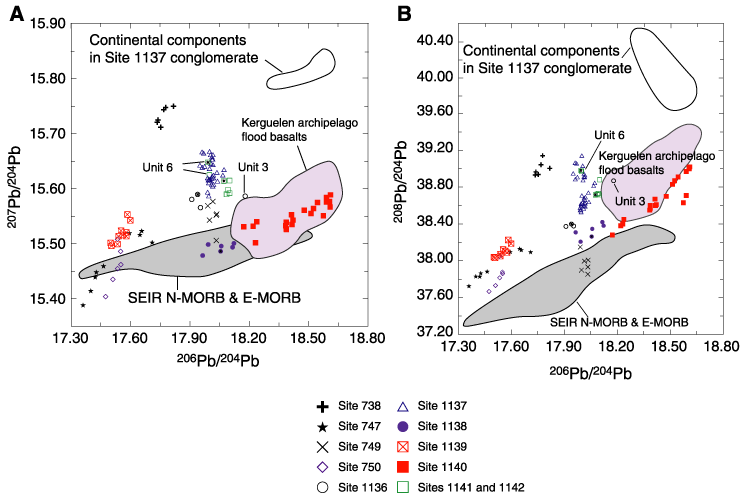
Figure F9. A, B. 207Pb/204Pb and 208Pb/204Pb vs. 206Pb/204Pb for mafic rocks, dominantly tholeiitic basalt recovered by drilling the igneous basement of the Kerguelen Plateau and Broken Ridge. Also shown is a field for the clasts of continental material in the conglomerate at Site 1137 (Ingle et al., 2002a). The anomalous Unit 3 at Site 1136 and Unit 6 at Site 1142 are labeled. There are four points with a black "x" within the symbol, one each for Sites 1136 and 1138 and two for Sites 1141/1142 including the anomalous Unit 6 at Site 1142. These points indicate unpublished data of D. Weis for geochemical reference samples selected to assess interlaboratory differences. The results demonstrate the agreement of isotopic ratios for acid-leached samples obtained in the laboratories of D. Weis (Université Libre de Bruxelles) and J. Mahoney (University of Hawaii). Because U-Th-Pb abundance data are not available for all samples, the data are not age corrected; however, the major features of the plots are not significantly affected by age correction (e.g., see table 2 of Neal et al., 2002). Data sources are Site 738 (Mahoney et al., 1995), Sites 747, 749, and 750 (Frey et al., 2002b), Sites 1136, 1138, 1141, and 1142 (Neal et al., 2002), Site 1137 (Weis et al., 2001; Ingle et al., 2002b), Site 1139 (Kieffer et al., 2002, only data for mafic lavas are plotted), and Site 1140 (Weis and Frey, 2002). Shown for comparison are fields for recent Southeast Indian Ridge (SEIR) mid-ocean-ridge basalt (MORB) and the Cenozoic (24-30 Ma) flood basalt forming the Kerguelen archipelago (data sources are Yang et al., 1998; Doucet et al., 2002; Frey et al., 2000b, 2002a; D. Weis, unpubl. data). N-MORB and E-MORB = normal and enriched MORB, respectively. Important features are (a) the relatively young (34 Ma) Site 1140 basaltic samples define a mixing trend between the fields for the Kerguelen archipelago and SEIR MORB (Weis and Frey, 2002). (b) Relative to the Kerguelen archipelago field, the Cretaceous LIP samples are offset to low 206Pb/204Pb. Aging of the source for 80 to 95 m.y. with 238U/204Pb = 10, a reasonable maximum, increases 206Pb/204Pb by <0.15; hence, the lower 206Pb/204Pb of the plateau lavas relative to the archipelago lavas cannot be explained by radiogenic ingrowth. Three sites (747, 750, and 1139) have lavas with very low 206Pb/204Pb, <17.8; in the 207Pb/204Pb vs. 206Pb/204Pb plot, data for these sites define a steeper trend than that of the MORB field. (c) When grouped together, a near-vertical trend of increasing 207Pb/204Pb and 208Pb/204Pb at a moderate 206Pb/204Pb of ~18 is defined by lavas from Sites 749 < 1138 < 1136 < 1141/1142 and 1137. Site 738 basalt also has high 207Pb/204Pb and 208Pb/204Pb but at a slightly lower 206Pb/204Pb.



![]()